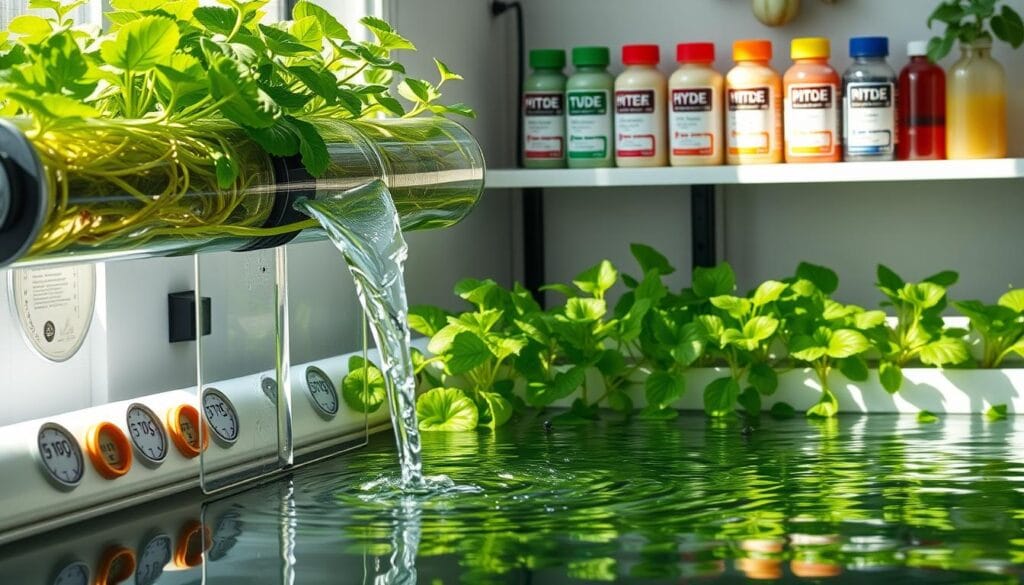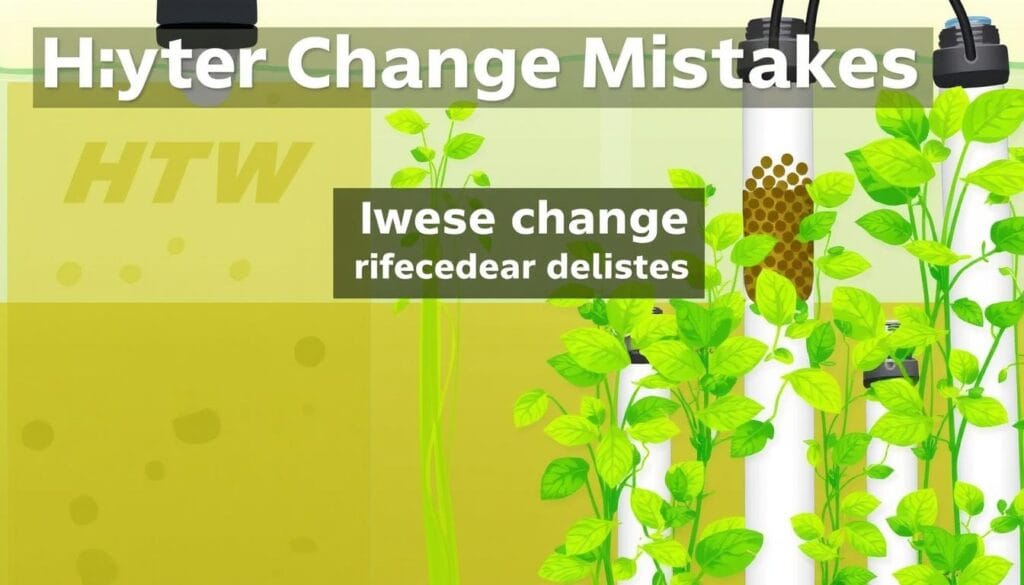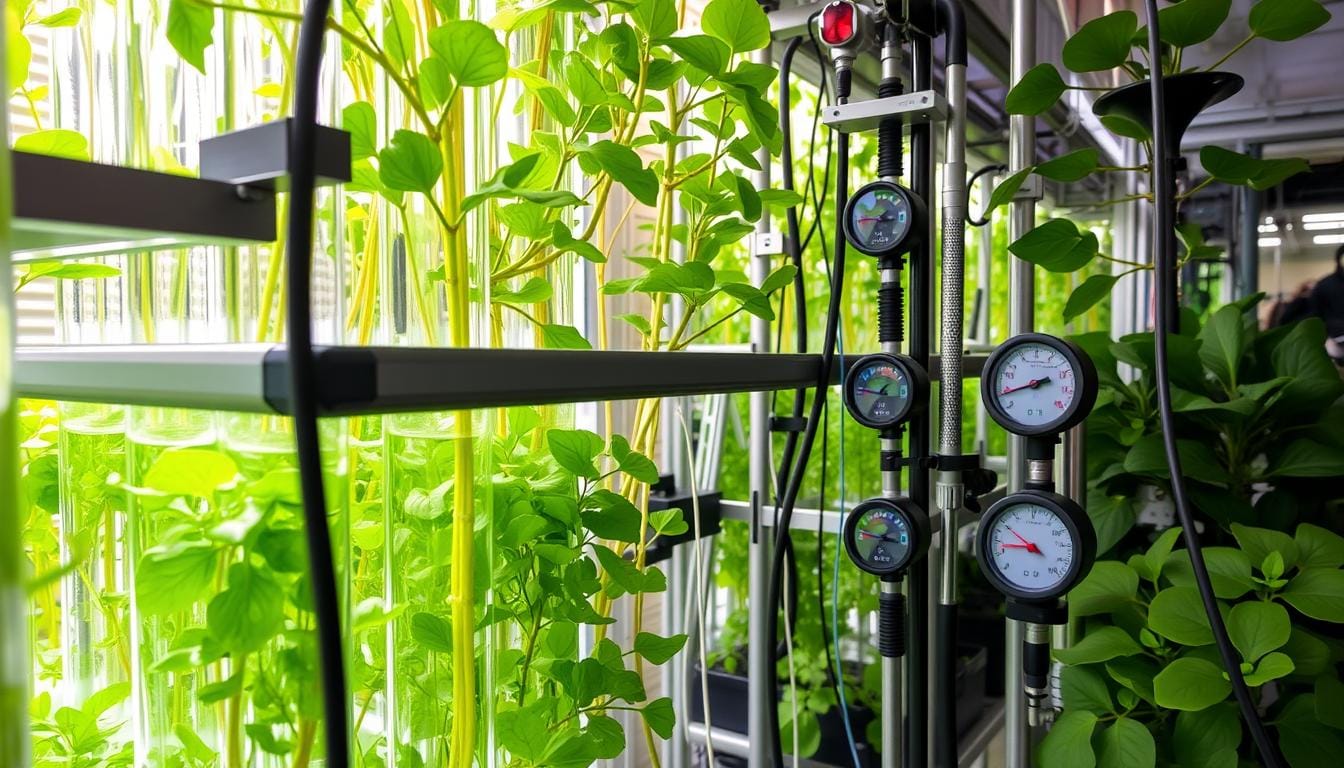Changing water in a hydroponic tube is key to keeping plants healthy and the system running smoothly. Growing plants in hydroponic systems is a dance of precision and care. My first setup was a mix of excitement and uncertainty.
Understanding water quality is essential in hydroponics. Your plants need the right environment for growth. Learning to change water is an art that makes your hydroponic tubes thrive.
Key Takeaways
- Water changes are critical for maintaining optimal hydroponic system performance
- Regular monitoring prevents nutrient imbalances and plant stress
- Different plants need different water change strategies
- Proper water testing is vital for long-term success
- Seasonal changes affect how often you need to change the water
- The size of your system impacts water management
- Clean water is essential for healthy plant growth
Understanding Hydroponic Water Management Basics
Hydroponic gardening changes how we grow plants by using water instead of soil. It’s key to know about water quality and how to manage it well.
Good water quality is the base of a successful hydroponic system. The right mix of nutrients, pH levels, and oxygen is vital for plant growth and system health.
Key Components of Water Quality
Managing water quality well means focusing on a few important things:
- pH Balance: Keeping it between 6.8 and 7.2
- Nutrient Solution Concentration
- Dissolved Oxygen Levels
- Water Purity
Hydroponics needs careful attention to these details. Starting with reverse osmosis water, which removes 98% of impurities, is a good choice for nutrient solutions.
Factors Affecting Water Changes
| Factor | Impact on Water Management |
|---|---|
| Plant Type | Determines nutrient needs and how often to change the water |
| System Size | Changes how much water you need and how often to maintain it |
| Environmental Conditions | Effects on how fast water evaporates and how nutrients are spread |
Impact on Plant Growth and Health
Your care of the hydroponic system affects plant growth. Good water management can cut growth cycles by up to 50% compared to traditional gardening. Plants in hydroponics get nutrients directly and grow better because of it.
“Water in hydroponics is not merely a medium—it’s the critical lifeline for your plants.”
Knowing the basics of water management helps plants thrive. This way, you can get the best yield and quality in your hydroponic system.
Signs Your Hydroponic System Needs a Water Change
Spotting early signs in your hydroponic system can stop crop failures and keep plants healthy. Knowing these signs is key to a thriving hydroponic setup.
- Nutrient deficiencies show as yellow leaves or slow growth
- Too much algae growth in the nutrient solution
- A big pH imbalance that messes with nutrient uptake
- Strange water discoloration
- Bad root health with visible damage or decay
Looking closely at your plants and the system is essential. This helps catch problems early.
Spotting issues early is the best way to avoid damage to your hydroponic system.
Here’s a quick guide to spotting when you need to change the water:
| Indicator | Potential Issue | Recommended Action |
|---|---|---|
| Yellowing Leaves | Nutrient Deficiency | Check and adjust the nutrient solution |
| Green Water | Algae Proliferation | Perform a complete water change |
| pH Below 5.5 or Above 6.5 | pH Imbalance | Recalibrate nutrient solution |
| Brown/Slimy Roots | Root Decay | Immediate water replacement |
Monitoring closely and taking quick action is essential for maintaining a healthy hydroponic system. By being quick to respond to these signs, you can help your plants grow well and avoid losing crops.
Changing water in a hydroponic tube: How often should you change it for optimal plant health?
Finding the right water change frequency is key for a healthy hydroponic system. How you manage nutrients affects your plants’ health and growth.
The best water change schedule depends on several important factors. Knowing these will help you get the most out of your hydroponic system.
Seasonal Water Change Requirements
Seasons change the need for water changes. In warmer months, you’ll need to change water more often because of:
- Increased evaporation rates
- Higher nutrient uptake by plants
- Faster metabolic processes
System Size Considerations
The size of your hydroponic system affects how often you need to change the water. Smaller systems need more frequent changes than larger ones.
| System Size | Recommended Change Frequency |
|---|---|
| Small (1-5 plants) | Every 1-2 weeks |
| Medium (6-15 plants) | Every 2-3 weeks |
| Large (16+ plants) | Every 3-4 weeks |
Plant Type Impact on Change Frequency
Each plant has its own nutrient needs, which can change how often you need to change the water. Fast-growing or nutrient-hungry plants need more frequent changes.
“Effective observation and quick adaptation are crucial in your hydroponic system.” – Hydroponic Expert.
Most hydroponic gardeners change their nutrient solution every two to three weeks. But, your specific setup might need different timing based on how your plants are doing and the environment.
Maintaining Proper Water Quality Between Changes

To keep your hydroponic system in great shape, you need to test the water often and take good care of it. The quality of your water is key to your plant’s health and how well they grow. It’s important to watch the water closely for any changes.
Here are some smart ways to keep your water quality up:
- Regular water testing for nutrient balance
- Precise pH adjustment
- Monitoring EC levels
- Preventing nutrient solution degradation
Using a digital pH meter is the best way to get accurate readings. Aim to keep pH levels between 5.5 and 6.5 for most crops. If the pH gets too far off, your plants might not get the nutrients they need.
“Water quality is the cornerstone of successful hydroponic gardening.” – Hydroponic Expert.
EC levels indicate the concentration of dissolved nutrients in the water. Different plants need different levels:
- Lettuce: 0.8 to 1.2
- Tomatoes: 2.0 to 5.0
- Basil: 1.5 to 2.0
Make a regular maintenance plan. Replace the nutrient solution every two to three weeks. Clean the pumps every month, and disinfect the system between crops. Use top-notch water and nutrients to avoid contamination.
By keeping a close eye on your system, you can avoid most problems. Regular checks and quick fixes help keep your plants happy and healthy.
Testing and Monitoring Water Parameters
Keeping water quality right is key for hydroponic gardening success. You need special tools to watch important water factors that affect plant health and growth.
Essential Testing Equipment
To manage your hydroponic system well, you’ll need a few important tools:
- pH meters for measuring acidity levels
- EC meters to check electrical conductivity
- Dissolved oxygen meters
- Comprehensive nutrient testing kits
Optimal Parameter Ranges
Knowing the best ranges for your hydroponic system is vital for plant success:
| Parameter | Ideal Range | Impact on Plants |
|---|---|---|
| pH Level | 5.5 – 6.5 | Ensures optimal nutrient absorption |
| EC Levels | 1.2 – 2.0 mS/cm | Indicates nutrient concentration |
| Dissolved Oxygen | 5+ mg/L | Supports root health and growth |
Recording and Tracking Results
Consistent monitoring turns your hydroponic system into a precise setup. Keep a detailed log of:
- Daily water parameter measurements
- Plant growth observations
- Nutrient solution adjustments
- Environmental conditions
“In hydroponics, what you measure, you can manage.” – Hydroponic Experts
Investing in good water quality monitoring tools and following a systematic approach helps your plants thrive. This way, they grow efficiently and healthily.
Best Practices for Water Change Procedures
Mastering hydroponic maintenance is all about careful attention to detail. You need to focus on replacing the nutrient solution and cleaning the system. This is key to keeping your plants healthy and growing well.
Here are the main steps for a successful water change:
- Drain the existing nutrient solution completely
- Inspect system components for any damage
- Clean all tubes and equipment well
- Rinse surfaces with the right disinfectant
- Make a fresh nutrient solution that matches your plants’ needs
Professional growers have some top tips for keeping your system in top shape:
- Keep the nutrient solution temperature between 18°C to 22°C
- Check pH levels, aiming for 5.5 to 6.5
- Regularly test electrical conductivity (EC)
- Swap out the nutrient solution every two to three weeks.
“Regular sanitization is the cornerstone of successful hydroponic cultivation.”
Always use top-quality water and nutrients when doing water changes. Follow strict cleaning steps to avoid pathogens. This keeps your hydroponic system running smoothly and your plants thriving.
Nutrient Solution Management During Water Changes
Managing hydroponic nutrients is key to a healthy plant ecosystem. Your nutrient solution is vital, needing careful attention during water changes.
Mixing New Nutrient Solutions
When mixing new nutrients, remember these important steps:
- Start with high-quality, filtered water
- Measure nutrient ratios accurately with a scale
- Consider a two-part nutrient system for better control
- Mix well to avoid nutrient separation
Maintaining Precise Nutrient Balance
EC management is all about regular checks and tweaks. Strive for optimal nutrient levels by testing and making adjustments.
“Precision in nutrient management is what distinguishes good hydroponic systems from great ones.”
To keep nutrient levels balanced, do the following:
- Test EC levels with a digital meter
- Use pH buffers to keep acidity stable
- Adjust nutrients based on plant growth
- Top up with more concentrated nutrients for water loss
Monitoring Nutrient Dynamics
Closely monitor your system’s nutrient levels, as plants require varying nutrients at different stages of growth. Keeping track of these levels ensures that your plants receive the right nutrients at the right time for optimal development. For example, they need more nitrogen when growing and more phosphorus and potassium when flowering.
Pro tip: Test your system regularly to spot nutrient imbalances early and avoid plant stress.
Common Water Change Mistakes to Avoid

Keeping a hydroponic system healthy means watching the water closely. Many growers make mistakes during water changes that harm their plants.
One big mistake is overfeeding. Too many nutrients can cause salt build-up and upset the balance plants need to grow well. It’s important to measure and watch your nutrient solution carefully.
- Avoid sudden pH shock by making gradual adjustments
- Prevent temperature fluctuations that stress plant roots
- Eliminate possible contamination sources
- Follow strict cleaning steps
Keeping the water temperature right is also key. Quick changes can shock the roots, hurting growth. Keep the water between 65-72°F for healthy plants.
| Common Mistake | Potential Consequence | Prevention Strategy |
|---|---|---|
| Improper cleaning | Pathogen introduction | Use food-grade hydrogen peroxide (1:10 dilution) |
| pH inconsistency | Nutrient lockout | Maintain pH between 6.0-7.0 |
| Contamination | Root disease | Use sterile equipment |
“In hydroponics, precision is the driving force behind success.” – Hydroponic Expert
Doing water changes right needs a lot of attention to detail. Watch your plants closely, manage nutrients well, and clean regularly. This way, you can avoid common mistakes and keep your hydroponic system healthy.
Conclusion
Successful hydroponic gardening depends on good water management. The health of your plants is tied to the quality of your water and regular system checks. Knowing how to optimize your nutrient solution is key to a healthy garden.
Keeping an eye on your water and changing it often is vital. Your system needs the right pH levels, between 5.5 to 6.5, and temperatures between 18°C to 22°C. Regular water changes prevent sediment, algae, and pathogens that harm your plants.
Regularly check your plants and track your water’s quality. Make sure to check pH and EC levels after water changes. This ensures your plants grow well. By following these steps, you’ll have a healthy, productive garden.
Every hydroponic system is different, needing its own care. Tailor your maintenance to fit your setup, plants, and environment. With the right care and water management, your garden will thrive and give great results.

